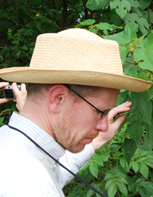Richard Telford’s Blog
 @richardjtelford
@richardjtelford
Recent Comments
-
Recent Posts
- Resampling Assemblage Counts
- A demo targets plan for reproducible pipelines for Neotoma data
- Reproducibility of high resolution reconstruction – one year on
- Simplistic and Dangerous Models
- COVID-19, climate and the plague of preprints
- Erroneous information … was given
- Making a pollen diagram from Neotoma
Archives
Categories
Tags
- analogue quality
- autocorrelation
- Baffin Island
- Barycentre
- Benthic foraminifera
- Bob Irvine
- Bulafu et al (2013)
- calibration-in-time
- China
- chironomids
- chrysophytes
- climate models
- critical transition
- data archiving
- diatoms
- Dietl (2016)
- dinocysts
- Doug Keenan
- EDA
- graphics
- Guiot and de Vernal (2011)
- h-block cross-validation
- Heartland
- impact
- INTIMATE training school
- Kelsey et al 2015
- Klein et al (2013)
- Klemm et al 2013
- lake level
- Lake Silvaplana
- Larocque-Tobler et al (2010)
- Larocque-Tobler et al (2011)
- Larocque-Tobler et al (2012)
- Larocque-Tobler et al (2015)
- LGM
- Liu et al 2014
- Lyons et al 2016
- maps
- Marcott et al 2013
- Mauri et al (2015)
- Miller et al 2013
- moss
- Murry Salby
- neotoma
- NIPCC
- Norway
- ocean acidification
- ordination
- palaeoSig
- Peer review
- Planktonic foraminifera
- Poland
- pollen
- R
- radiocarbon calibration
- radiocarbon dating
- Reconstruction diagnostics
- reconstructions
- REDFIT
- Schulz & Mudelsee (2002)
- Sea ice
- sea ice reconstruction
- Skjærvø et al (2015)
- spatial autocorrelation
- Spectral analysis
- Tatra Mountains
- Telford (2006)
- Telford and Birks (2011)
- Testate amoeba
- Transfer function diagnostics
- Uganda
- uneven sampling
- Willie Soon
- Younger Dryas
- Zhang et al 2017
Blogroll
Follow me on Twitter
My TweetsMeta
- Follow Musings on Quantitative Palaeoecology on WordPress.com
Category Archives: Age-depth modelling
The three chronologies from Seebergsee
Accurate and precise chronologies are important for all comparisons of palaeoecological records. This is especially true for the validation of sub-decadal resolution reconstructions against instrumental data: a chronological error of only a year or two will seriously degrade the apparent … Continue reading
The ‘New York’ principle of site selection
If I can make it there, I’ll make it anywhere. It’s up to you, New York, New York. Palaeoecologists typically try to choose sites where the environmental variable they want to reconstruct is likely an important, ideally the most important, … Continue reading
OxCal and R
OxCal is perhaps the most powerful of the three main Bayesian age-depth modelling procedures, with many many options and the potential for building far more complicated than your typical palaeolimnologist needs to use. Unlike Bchron and Bacon, OxCal is not … Continue reading
Did the floating bog quiver in the sunshine?
The current edition of The Holocene has a paper by Xu et al that reports a relationship between solar activity and millennial-scale failures of the Indian Summer Monsoon as recorded in peat deposits of Lake Xihu, southwestern China. Is this robust evidence … Continue reading
Posted in Age-depth modelling, Peer reviewed literature, solar variability
Tagged Xu et al (2015)
Leave a comment
Private prosecutions as an alternative to publications
When you read a paper you disagree with, you have a number of options. The easiest is to shrug one’s shoulders and mutter darkly that nothing better could be expected from that lab. More productively, one can write a blog … Continue reading
Posted in Age-depth modelling, Fake climate sceptics, Silliness
Tagged Doug Keenan, radiocarbon dating
2 Comments
Time to recalibrate those radiocarbon dates?
Radiocarbon dating is probably the most important dating technique for palaeoecological research in the late Quaternary. One complication with 14C dating is that the concentration of 14C in the atmosphere has changed over time due to, for example, solar-driven changes … Continue reading
